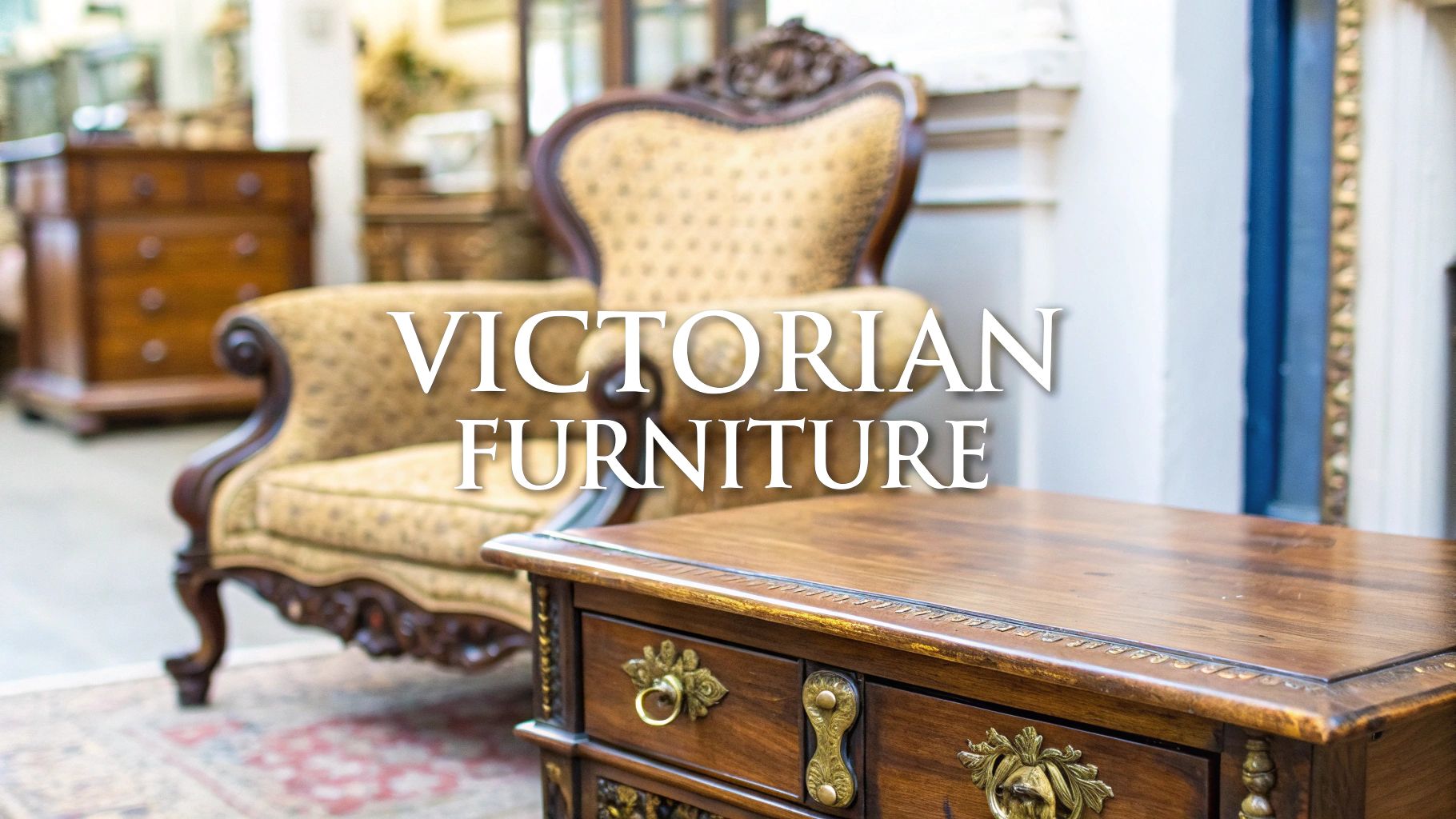When you think of Victorian furniture, what comes to mind? Probably dark, heavy woods, elaborate carvings, and a sense of grandeur that feels a world away from today’s minimalist trends. You’d be right. The furniture made during Queen Victoria's reign, from 1837 to 1901, was all about making a statement. It was ornate, substantial, and deeply symbolic of the era's massive industrial and social shifts.
This was the first time in history that heavily decorated furniture could be mass-produced, and a rising middle class was eager to furnish their homes with pieces that looked as rich and impressive as those of the aristocracy.
Understanding the Victorian Aesthetic
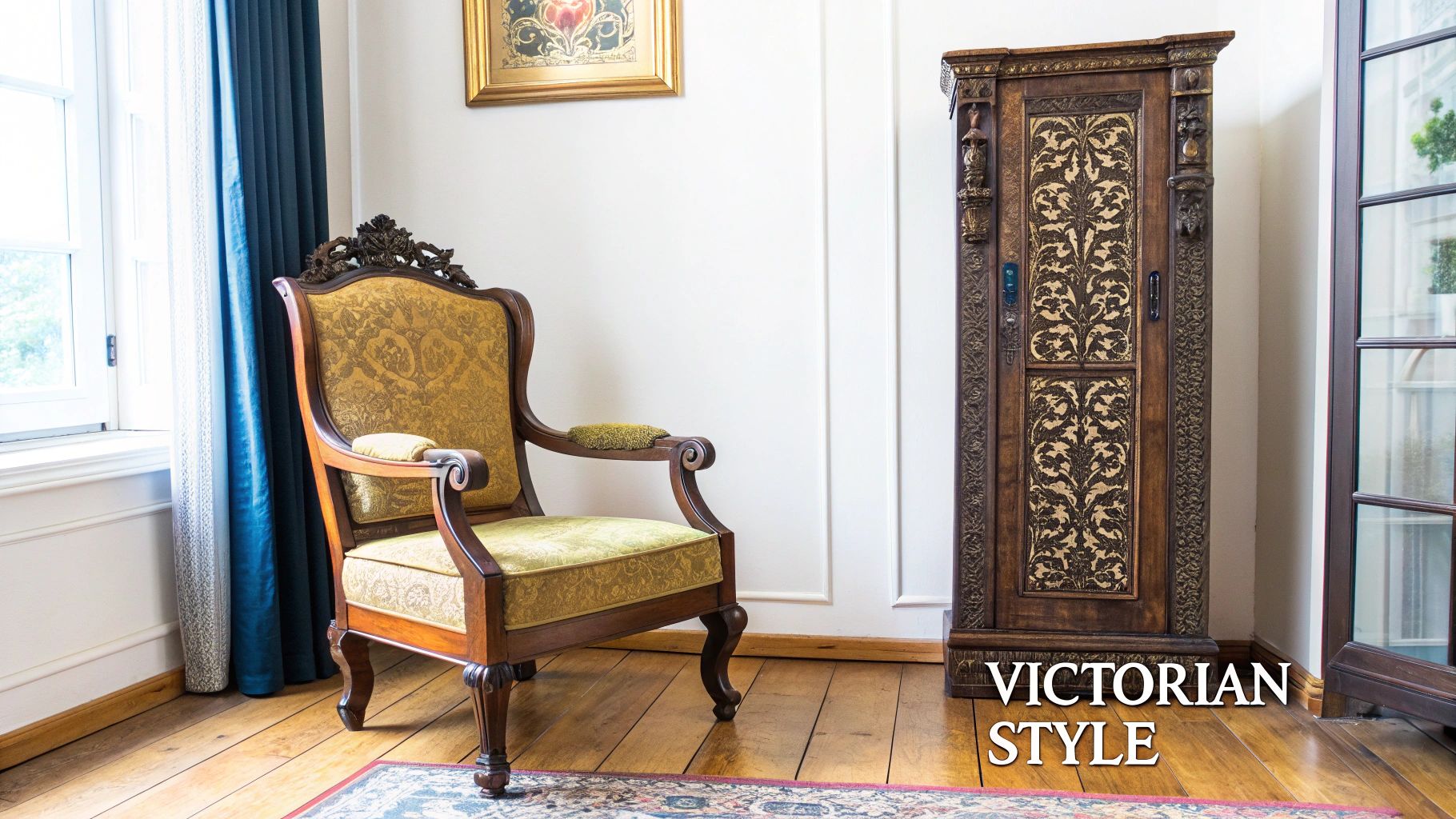
Forget everything you know about clean lines and "less is more." To get a feel for the Victorian aesthetic, you have to imagine a 19th-century home where furniture wasn't just functional—it was a performance. Every curve and carving was a deliberate display of wealth, morality, and social standing in a society experiencing profound change. Ornamentation was the main event, not an afterthought.
The Industrial Revolution's Impact
So, what fueled this dramatic shift? The Industrial Revolution. It completely upended furniture making, moving it from the small, quiet workshop of a lone artisan to the noisy, steam-powered factory floor.
Suddenly, machines like steam-powered saws and lathes could crank out complex, carved components in a fraction of the time it took to do by hand. This leap in technology made it possible to mass-produce the kind of ornate furniture that once took months to create. You can dive deeper into this evolution of the Victorian furniture trade to see just how radical this change was.
This wasn't just a manufacturing story; it was a social one. For the very first time, a family didn't need a title to afford beautiful furniture. The newly prosperous middle class had money to spend and a powerful desire to show it off.
A family’s parlor was no longer just a living room; it became a public showroom of their prosperity, filled with pieces that spoke volumes about their social ambitions.
The home became a stage, and the furniture was the star. A heavily carved sideboard or a deeply tufted settee wasn't just a place to put things or sit—it was a testament to the family's success and taste.
Core Visual Characteristics
Of course, styles changed a lot over Queen Victoria’s long reign, but some visual hallmarks are true dead giveaways. If you're trying to spot a piece of Victorian era furniture, these are the clues to look for.
- Dark, Heavy Woods: The go-to choices were mahogany, walnut, and rosewood. Their deep, rich tones gave every piece a serious, formal weight.
- Intricate Carvings: Forget simplicity. Victorian furniture is absolutely covered in detailed carvings. Think fruits, flowers, leaves, and animals—all designed to signal sophistication.
- Plush, Luxurious Upholstery: With the invention of the coiled spring, comfort became key. Sofas and chairs were draped in rich fabrics like velvet, damask, and brocade, often in deep jewel tones and featuring tufting.
- Curvaceous Lines: Straight, hard lines were often avoided. Instead, you'll see sweeping S-scrolls and C-scrolls that give pieces a sense of romance and movement.
Ultimately, these features all circle back to one core idea: for the Victorians, more was definitely more. Every detail was part of a bigger story about a family's identity and its place in a quickly modernizing world.
Exploring the Major Victorian Design Styles
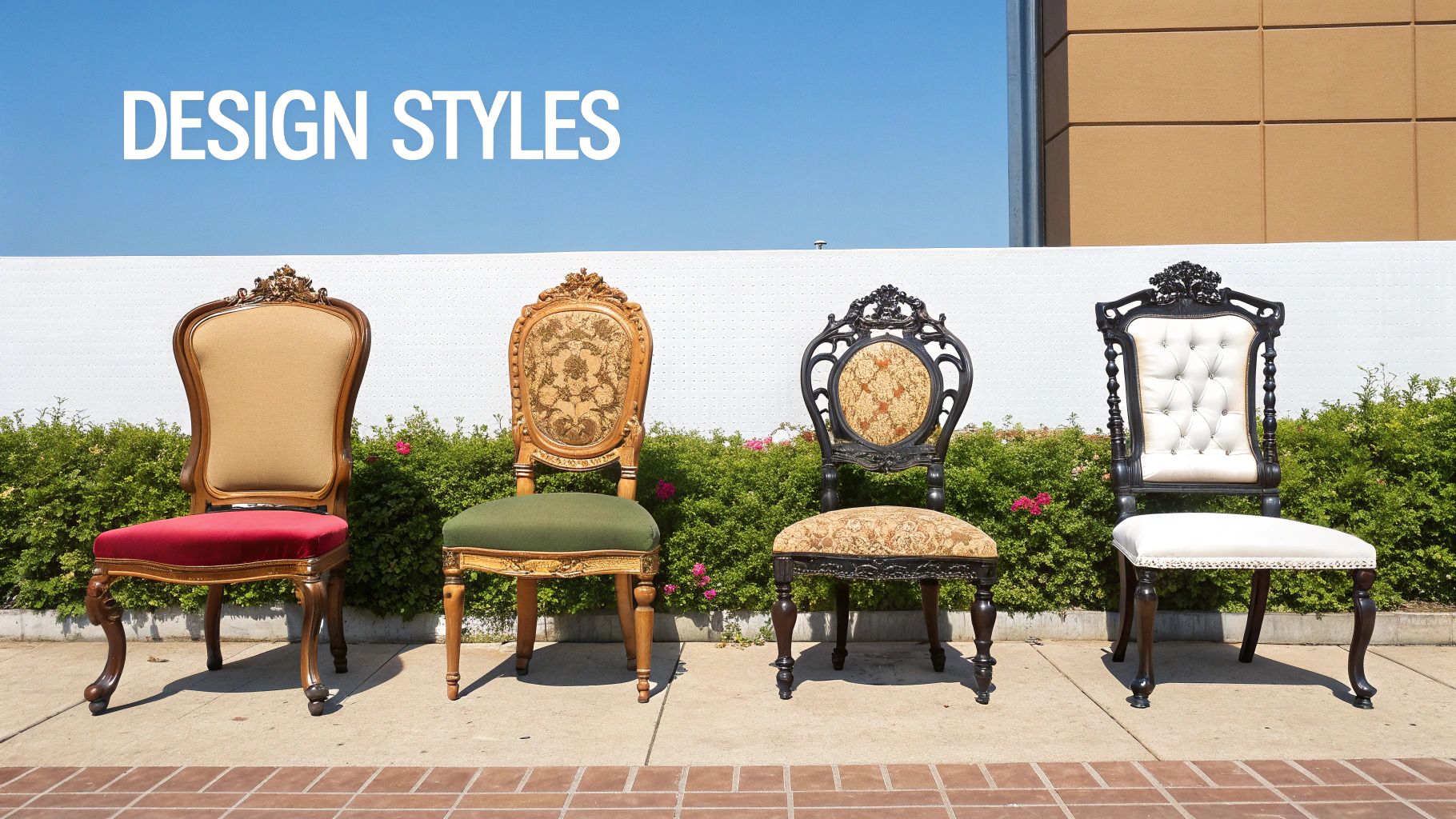
The first thing to understand about Victorian furniture is that it isn't one single style. It's more like a collection of dramatic “revival” movements that all happened under one long reign. Designers of the time were like historical remix artists, constantly looking back to the past for inspiration and then reinterpreting those classic forms for a new, industrial age.
This created a fascinating, and sometimes dizzying, mix of furniture where styles could overlap, blend, and evolve in a short span of time. Each revival had its own distinct personality—a specific language of shapes, carvings, and materials. Learning to tell them apart is the key to unlocking the story of any 19th-century piece you come across.
Gothic Revival: The Drama of the Middle Ages
Early in the Victorian era, designers were completely captivated by the romance and grandeur of the Middle Ages. The Gothic Revival style took its cues directly from the soaring cathedrals of Europe, essentially bringing the architectural weight of a church right into the living room. It was a bold, serious statement against the lighter, more delicate styles that came before it.
This furniture was meant to feel substantial, historic, and maybe even a little pious. To spot a Gothic Revival piece, keep an eye out for these key features:
- Pointed Arches: This is the dead giveaway. You’ll see them carved into the backs of chairs, forming the doors of a cabinet, or shaping a massive headboard.
- Intricate Tracery: Look for delicate, lace-like carvings that copy the elaborate stone tracery you'd find in a medieval cathedral window.
- Heavy, Solid Woods: Oak was the wood of choice, selected for its sturdiness and its historical connection to old-world craftsmanship.
Rococo Revival: The Romance of the Curve
By the middle of the 19th century, tastes began to swing toward something softer and more romantic. The Rococo Revival looked back to 18th-century France, celebrating lush curves, flowing lines, and natural, organic forms. It quickly became one of the most popular and recognizable styles of the entire Victorian period.
This style is all about fluid motion and graceful elegance. Signature motifs like the S-scroll and C-scroll give every piece a sense of movement. It's a joyful, almost theatrical expression of nature and luxury.
The undisputed American master of this style was John Henry Belter. He was famous for his laminated rosewood furniture, a technique that allowed for impossibly deep and complex carvings of fruit, flowers, and vines that would have been impossible with solid wood.
Rococo Revival sofas and chairs often seem to be practically dripping with decoration, making them highly sought-after by collectors today. This style truly captures the opulent, "more-is-more" spirit we often associate with Victorian design.
Renaissance Revival: A Return to Classical Order
As the century wore on, some people grew tired of the Rococo’s constant, flowing curves. This led to the Renaissance Revival, a style that favored a more formal, architectural look inspired by the grand palaces of 16th-century Italy and France. It's a stately, often masculine style, heavily ornamented with classical details.
This one is much easier to identify thanks to its strong, almost blocky forms.
- Architectural Elements: Pieces often look like miniature buildings, complete with columns, pediments, and other structural features.
- Bold Carvings: Forget delicate flowers. Here, you'll find carved busts of historical figures, powerful animal heads (especially lions), and deep, geometric patterns.
- Marquetry and Inlay: High-end pieces frequently featured intricate pictures or patterns created by inlaying different types of wood, bone, or mother-of-pearl.
This was furniture designed to project an image of wealth, power, and intellect. Its massive scale was a perfect fit for the sprawling new homes of America's and Britain's top industrialists.
Eastlake Movement: Reform and Simpler Forms
Towards the end of the era, a rebellion started brewing. Designers like Charles Eastlake got fed up with what they saw as the overly ornate, dishonestly constructed furniture of the major revival styles. The Eastlake Movement championed simpler lines, honest construction, and a more restrained, geometric form of decoration.
This back-to-basics approach was a direct slap in the face to industrial excess. Instead of deep, three-dimensional carvings, Eastlake furniture features shallow, incised lines and geometric patterns cut by machine. You'll see more straight lines and fewer curves, often crafted from oak, walnut, or cherry. It was a move toward letting the material's natural beauty speak for itself, without all the fuss.
To help you keep these styles straight, here's a quick comparison of the big players in the Victorian design world.
Comparing Major Victorian Furniture Styles
| Style | Typical Period | Key Characteristics | Common Motifs |
|---|---|---|---|
| Gothic Revival | 1830s - 1860s | Heavy, architectural, serious | Pointed arches, tracery, trefoils, spires |
| Rococo Revival | 1840s - 1870s | Ornate, curvy, naturalistic | C-scrolls, S-scrolls, flowers, grapes, leaves |
| Renaissance Revival | 1850s - 1880s | Formal, masculine, monumental | Columns, pediments, lion heads, cartouches, inlay |
| Eastlake Movement | 1870s - 1890s | Geometric, simpler, rectilinear | Incised lines, geometric patterns, spindles |
This table is a great starting point, but remember that these styles often bled into one another. It wasn't uncommon for a piece to have Rococo curves and a dash of Renaissance Revival carving.
The rapid evolution of these styles was fueled by a booming industrial economy. By the mid-19th century, furniture manufacturing was a massive employer. London alone was a preeminent center, hosting over 2,000 specialized businesses covering at least twenty-four different trades related to furniture making. This incredible production capacity, detailed in research on the London furniture trade, allowed each of these distinct styles to flourish and find a place in homes all across the social spectrum.
Common Materials and Craftsmanship Techniques
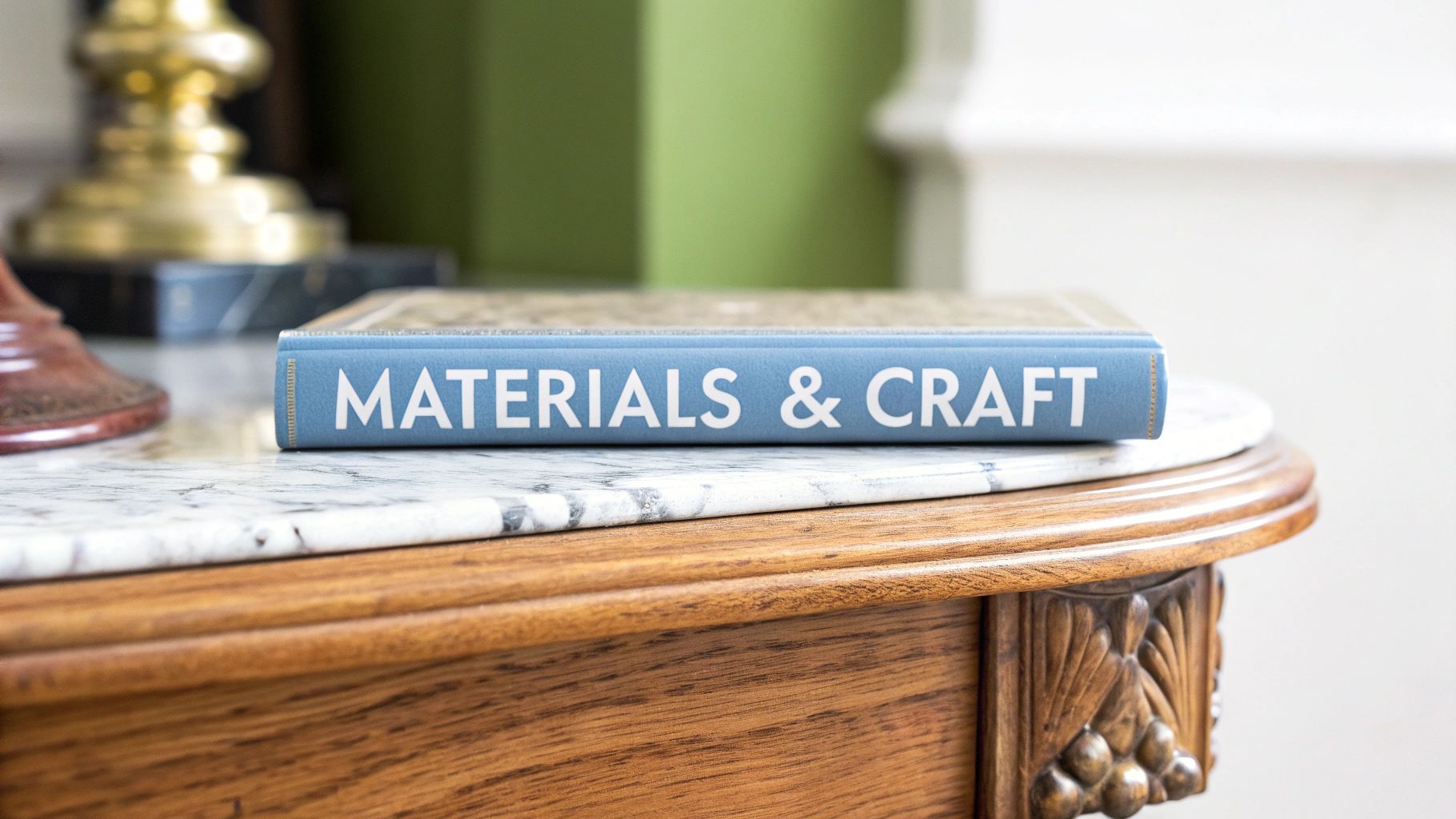
The heavy, imposing look of furniture from the Victorian era didn't just appear out of nowhere. It was the product of a perfect storm: a flood of new materials from across the globe and new technologies that changed woodworking forever. The soul of this style is really found in its deep, rich timbers and the factory innovations that made such grand designs possible for more people.
Think of it this way: the materials were the artist's paint, and the new technology was a whole new set of brushes. The era’s palette was dominated by dark, dramatic woods shipped in from all corners of the British Empire. These weren't just picked for strength; they were chosen for their visual punch and their ability to hold the intricate carvings that defined the period.
The Signature Woods of Victorian Design
Walk into a room filled with authentic Victorian furniture, and the first thing you'll feel is the sheer presence of the wood. A few key types really defined the look, each with its own character that helped create the formal, substantial atmosphere homeowners of the time craved.
- Mahogany: Without a doubt, this was the king of Victorian woods. Its deep reddish-brown color, straight grain, and incredible durability made it the top choice for dining tables, massive sideboards, and bedroom sets built to last for generations.
- Walnut: A very close second in popularity. People loved its rich, dark color and beautiful swirling grain patterns, making it a favorite for elegant parlor chairs and decorative tables.
- Rosewood: This was the true luxury option. Even darker and more dramatic, this exotic wood was often reserved for the absolute finest pieces, especially during the Rococo Revival years.
While these dark timbers really set the tone, you'll also spot lighter woods like oak and ash. They became particularly popular in Gothic Revival furniture and the later Arts and Crafts pieces, which were often a reaction against all that industrial production.
The Factory Revolution in Furniture Making
The materials provided the potential, but technology unlocked it. The Industrial Revolution completely upended woodworking. Tasks that once took days of painstaking hand labor could now be done with speed and precision by steam-powered machines.
The Victorian factory was a hotbed of innovation. Steam-powered saws sliced through timber with unbelievable speed, while new lathes could churn out complex, ornate table legs as a routine job. This marriage of machine power and beautiful wood is what allowed decorative furniture to become a mass-market product for the first time.
A key breakthrough was the widespread use of veneers. New machines could slice expensive woods like rosewood into paper-thin sheets. Cabinetmakers then glued these veneers onto a cheaper base wood, giving a piece a luxurious look for a fraction of the cost.
This clever trick brought the appearance of high-end furniture within reach of the burgeoning middle class. In a similar vein, steam-bending technology made it possible to create the swooping curves of a Rococo Revival chair without having to carve it from a massive, solid block of wood, which saved an enormous amount of time and resources.
An Innovation That Redefined Comfort
Believe it or not, the most important technological leap for Victorian era furniture comfort had nothing to do with wood. The invention and mass production of the coiled spring was a complete game-changer for seating.
Before coiled springs, chairs and sofas were just stuffed with things like horsehair or straw. This stuffing would pack down over time and offered very little support. The adoption of coiled springs is what gave us the deep, truly comfortable seating we associate with the period. It’s the reason you see all that deep button-tufting and the plush, overstuffed look in armchairs and sofas—the entire design was built around this new, springy foundation.
Of course, other materials added to the opulent look:
- Marble Tops: Washstands, tables, and sideboards were often topped with heavy slabs of white or grey Carrara marble, which added a touch of classical elegance and was easy to clean.
- Ornate Hardware: Brass was the go-to metal for drawer pulls, hinges, and keyhole covers. These were often cast in intricate floral or animal designs.
- Rich Fabrics: Seating was upholstered in luxurious materials like velvet, damask, and brocade, usually in deep jewel tones like burgundy, forest green, and royal blue.
All these elements worked together, creating furniture that wasn't just functional but was also a powerful statement of a family's style and social standing.
How to Identify Authentic Victorian Furniture
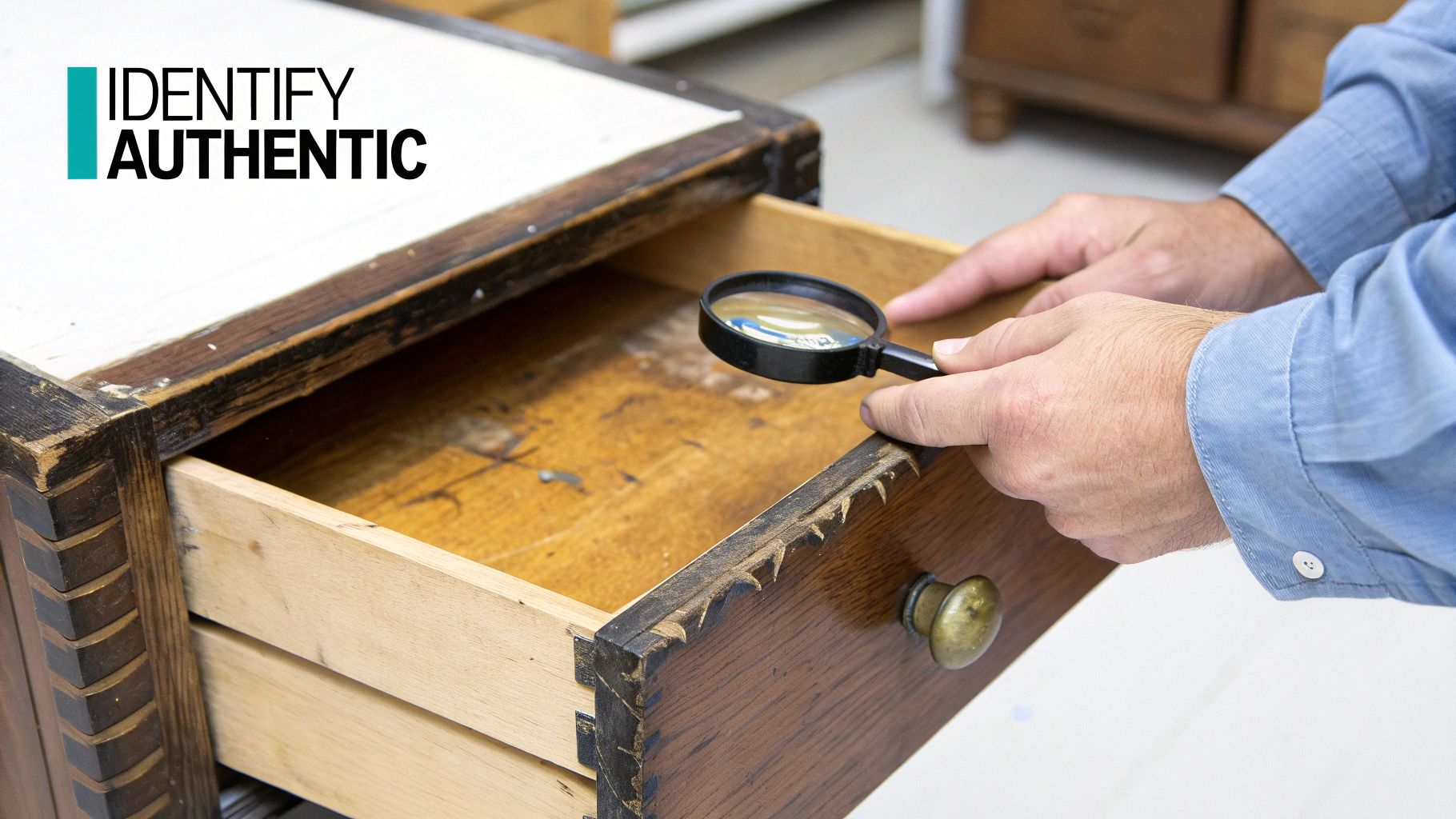
Telling a true antique from a well-made copy can feel like a treasure hunt. When you're dealing with furniture from the Victorian era, it's rarely a single "aha!" moment. Instead, you're piecing together a story from small clues, acting like a detective with wood, joints, and hardware as your key witnesses.
Once you learn to read these signs, you'll start spotting the tell-tale marks of 19th-century craftsmanship. A genuine piece shows its age gracefully, with a rich patina and minor imperfections that prove it has lived a long life. Let’s walk through the essential things to inspect to make you a more confident antique hunter.
Start with the Wood and Finish
The most immediate clue is the wood itself. Victorians loved using dark, heavy timbers like mahogany, walnut, and rosewood for their more formal pieces. But the finish is often the real giveaway. After more than a century, an original shellac or varnish finish darkens and develops a deep, mellow glow called patina.
This unique luster is almost impossible to fake. You should also be on the lookout for honest signs of aging that tell the piece's story.
- Faint water rings: The ghosts of glasses left on a surface over many decades.
- Minor scratches and dents: Evidence of everyday use that adds character, not detracts from it.
- Slight color variations: You might notice areas that received more sunlight are a bit lighter than the rest.
These so-called "flaws" are actually signs of authenticity that seasoned collectors cherish. A piece that looks too perfect is often a red flag, suggesting it might be a newer reproduction.
A genuine antique often tells its story through its imperfections. The gentle wear, the subtle fading, and the darkened finish are not defects; they are the authenticating marks of a piece that has been a part of people's lives for over 150 years.
Examining these details closely is the first step. For those looking to go deeper, our broader guide on how to identify antique furniture can provide even more foundational tips.
Examine the Construction Details
How a piece was put together tells you a great deal about its age. The Victorian era was a time of transition, moving from entirely handmade to machine-assisted construction, and the joints are a clear record of that evolution.
Dovetail joints, which lock drawer corners together, are a fantastic place to start your inspection.
- Early Victorian (c. 1840-1860): These pieces will usually have large, slightly irregular, hand-cut dovetails. The "pins" and "tails" of the joint won't be perfectly identical because they were made by a craftsman, not a machine.
- Late Victorian (c. 1860-1901): As machines became more common, dovetails got much more precise. Look for small, clean, and perfectly uniform joints that signal machine assistance.
Don't forget to check the back of a piece just as carefully as you admire the front. Turn that chest of drawers around and look at the backboards. Real Victorian furniture often has straight, up-and-down saw marks left by the huge circular saws used in 19th-century mills. Modern pieces will have much smoother, more uniform surfaces.
The weight is another crucial clue. Victorians used solid wood, making their furniture incredibly heavy. If a big, imposing sideboard feels strangely light, it could be a modern reproduction made with cheaper materials like particleboard hidden underneath a veneer.
Check the Hardware and Upholstery
The final clues are hiding in the details—the drawer pulls, keyholes, and even the hidden stuffing. Finding original hardware is a real score and adds significant value to any piece of furniture from the Victorian era.
Look for brass pulls that show their age with a soft, worn patina, not a bright, artificial shine. Keyholes, often made of brass or even bone or ivory, should have tiny scratches around the opening from years of keys turning. If the piece is upholstered, try to see what's inside.
Original stuffing in Victorian furniture was made from materials like horsehair, hay, or cotton. If you peek inside a cushion and see bright white, perfectly uniform foam, the piece has either been completely reupholstered or is a modern creation.
Lastly, check the fasteners. Reproductions often use modern screws. Original Victorian pieces used hand-forged nails or screws with a simple single slot in the head—nothing like the Phillips-head screws we use today. It's these small details, when added up, that build a compelling case for a piece’s age and authenticity.
Collecting Victorian Antiques in Today's Market
So, you're looking at a heavy, ornate Victorian sideboard and wondering: is this a treasure or just... old furniture? It’s a great question, and the answer isn't as simple as it used to be. The market for Victorian pieces is a living, breathing thing, constantly shifting with interior design trends and what collectors are chasing.
For a long time, the dark, imposing furniture of the era was out of style, which meant you could find incredible bargains. But things are changing. A new generation is discovering the appeal of solid craftsmanship and one-of-a-kind historical pieces, and that’s breathing new life into the market. It’s a selective scene, though—quality and specific styles are now king.
What Collectors Are Looking For
Not all Victorian furniture is created equal in today's market. A massive, formal dining set might sit unsold for months, while other pieces get snapped up in a heartbeat. Knowing the difference is what separates a savvy buy from a storage headache.
- High-Style Pieces: The big names still carry a lot of weight. Think of the intricate, laminated rosewood masterpieces by John Henry Belter or the forward-thinking "reform" designs of Charles Eastlake. These pieces were the best of their time and will always command a premium.
- Unique Forms: Forget the common stuff for a moment. Collectors get excited about the unusual pieces—a clever Wooton desk with its countless compartments, a delicate inlaid etagere, or even a fainting couch with its original horsehair stuffing intact.
- Manageable Scale: Let's face it, most of us don't live in sprawling mansions anymore. Those monumental sideboards and bedroom suites are a tough fit for modern homes. On the other hand, smaller pieces like accent tables, hall trees, and elegant parlor chairs are incredibly versatile and in high demand.
The old mantra really holds true here: "buy the best you can afford." A single, fantastic piece in great shape will always be a better investment than a roomful of mediocre items. Look for impeccable condition, top-notch craftsmanship, and if you can find it, provenance—a paper trail that tells the piece's story.
Following this advice helps you build a collection that not only looks great but also holds its value. If you're just dipping your toes in, our guide on antique collecting for beginners is a great place to start building your confidence.
Key Factors That Determine Value
When it comes time to buy or sell, a few key things separate a dusty heirloom from a true collector's prize.
- Condition: This is everything. The original finish, hardware, and upholstery are what make a piece sing. Some honest wear is part of the charm, but major issues—cracks, missing chunks of veneer, or clumsy repairs—can slash the value by 50% or more.
- Rarity and Style: Was this a common, factory-made washstand produced by the thousands, or a rare, signed piece from a famous workshop? Certain styles, like Renaissance Revival and Eastlake, are really having a moment right now, while the more generic, mass-produced furniture tends to lag behind.
- Provenance: A good story can be worth real money. An original bill of sale or proof that a piece belonged to a prominent family adds a layer of history that collectors are absolutely willing to pay for.
- Authenticity: This is where a good eye comes in. You have to learn to spot the difference between a genuine antique and a later "Victorian-style" reproduction. Look for real signs of age, like the hand-cut dovetails on earlier furniture, hardware that’s right for the period, and the deep, glowing patina that only a century of life can create.
The good news is that the Victorian market is more approachable than it's been in years. There are amazing opportunities for both seasoned pros and curious newcomers. If you focus on quality, keep an eye on the trends, and do a little homework, you can find pieces you truly love or sell your own treasures for a fair price.
A Guide to Caring For Your Victorian Antiques
When you bring a piece of Victorian furniture into your home, you're not just an owner—you're a custodian of history. Your job is to enjoy its story and beauty while ensuring it survives for the next generation to appreciate. The best approach is always a gentle one. Think "less is more" to protect the integrity, charm, and value of these incredible pieces.
Your Home's Environment is Key
The first step in preservation has nothing to do with polish or wax; it's all about the room itself. Antique wood is surprisingly sensitive. It breathes, expanding and contracting with the seasons just like a living thing.
To keep it happy, you need a stable environment. Wild swings in temperature and humidity can cause the wood to dry out and crack, or swell up and warp. Try to maintain a steady humidity level in your home, ideally somewhere between 45% and 55%.
Sunlight is another major culprit. Those direct UV rays are incredibly harsh on antique finishes. Over time, they can bleach the deep, rich colors of woods like mahogany and walnut and cause the delicate original shellac to become brittle. It’s always best to place your most treasured pieces away from windows that get a lot of direct sun.
A Gentle Approach to Cleaning
Forget about modern, aggressive cleaning products. They can be disastrous for antique furniture, often stripping away the very patina that gives a piece its character and proves its age.
For routine upkeep, the simplest method is the best. A light, regular dusting with a soft, dry microfiber cloth is all you need to prevent dust from building up and scratching the finish.
If you're dealing with a bit of grime, you can slightly dampen a cloth with distilled water, wipe the surface, and immediately follow up with a dry cloth. Steer clear of any commercial sprays, especially those with silicone. They leave a cloudy film that is a nightmare to remove without professional help. Learning safely clean antique wood is one of the most important skills you can develop as a collector.
The point of cleaning an antique isn’t to make it look brand new. It's about preserving its gracefully aged beauty. That soft glow the wood has earned over a century—the patina—is a huge part of its history and its value.
If you ever need to move a piece or put it into storage, protecting it is non-negotiable. Using quality plastic furniture covers for moving or storage will shield it from dust, moisture, and accidental scuffs.
Knowing When to Call in a Pro
It can be tempting to roll up your sleeves and tackle a small repair yourself, but it's crucial to recognize your own limits. Knowing the difference between a simple fix and a major restoration can save a piece from being ruined forever.
Here’s a good rule of thumb:
- What you can probably do (DIY): Things like carefully tightening a loose screw on the original hardware or applying a little bit of paste wax to a finish that's in good shape are usually safe bets.
- When to call a professional: Leave the big stuff to an expert. This includes deep cracks in the wood, a broken leg, peeling or bubbling veneer, or an original finish that is flaking off.
A professional furniture conservator has the specialized knowledge to make repairs using the right materials and techniques for the period. This not only ensures the repair is done correctly but also protects the historical and financial value of your investment. Making that call is the best way to honor the artisan who created it more than a century ago.
Got Questions? We've Got Answers
Diving into the world of Victorian furniture can feel a bit overwhelming, and a few key questions tend to pop up again and again. Let's tackle some of the most common ones to help you get your bearings.
What’s the Single Biggest Telltale Sign of Victorian Furniture?
If you had to boil it down to one thing, it would be the sheer love of ornamentation. Victorian design wasn't about minimalism; it was a celebration of different historical styles all mashed together, from Gothic to Rococo.
This means you’ll almost always see furniture that is elaborately carved, heavily embellished, and just feels substantial. Think dark, rich woods like mahogany and walnut paired with deep, plush upholstery and details everywhere you look.
Was All Victorian Furniture Dark and Gloomy?
Not at all! While that dark, heavy look is what most people picture, it's really just one part of the story. The Victorian era was long, and styles changed dramatically over the decades.
Later styles, like the Aesthetic Movement and Eastlake, were actually a reaction against all that earlier fussiness. These pieces featured cleaner lines, simpler geometric carvings, and sometimes even lighter woods like oak. The focus shifted from over-the-top carving to a more honest, less cluttered design.
How Do I Know if It's a Modern Copy?
Spotting a reproduction comes down to looking for genuine signs of age and understanding how these pieces were originally made. An authentic antique has lived a long life, and it should show it—in all the right places, like worn chair arms or the wood around a drawer pull.
Here are a few things to check that a knock-off usually gets wrong:
- How it's put together: Check the dovetail joints in the drawers. Early Victorian ones will be slightly uneven because they were cut by hand, while later machine-cut dovetails look perfectly uniform.
- The hardware: Original screws, knobs, and pulls just look and feel different. They won’t be shiny and perfect. A single-slot screw is often a great sign you're looking at something genuinely old.
- The finish: A modern reproduction often has a flawless, almost plastic-like sprayed-on finish. A real antique has a patina—a deep, complex glow that only comes from a century of polishing, use, and exposure to life.
These little details are what separate a true piece of history from a modern imitation.
Uncover the story behind your own treasures. With the Curio app, you can instantly identify, learn about, and get an estimated value for your antiques right from your phone. Download Curio today and let your antiques tell their story.
